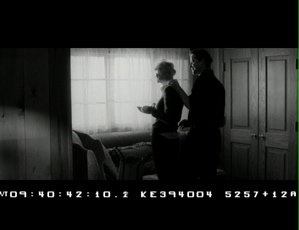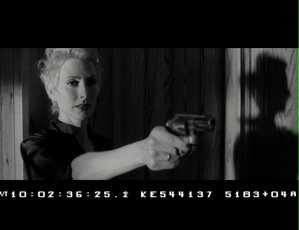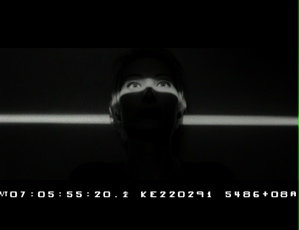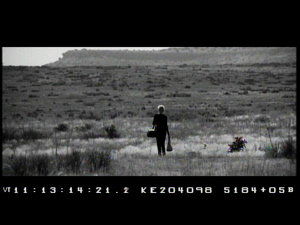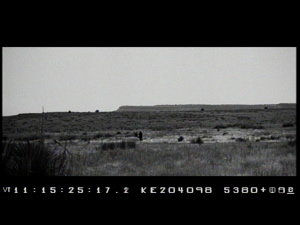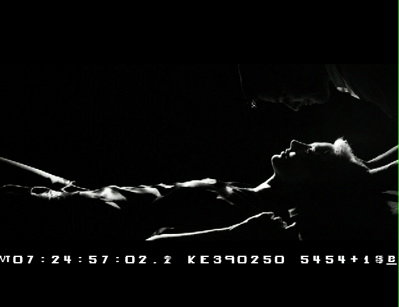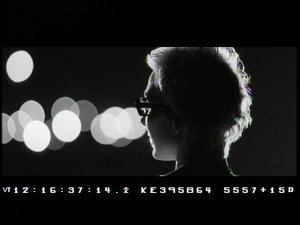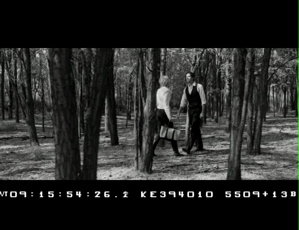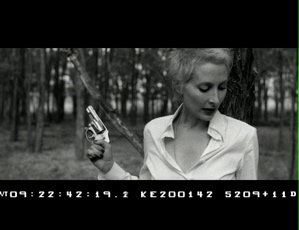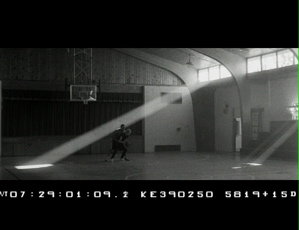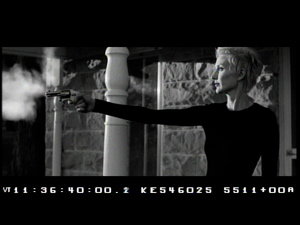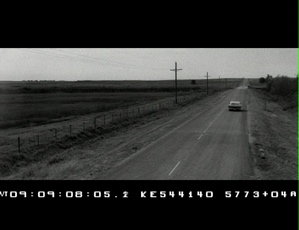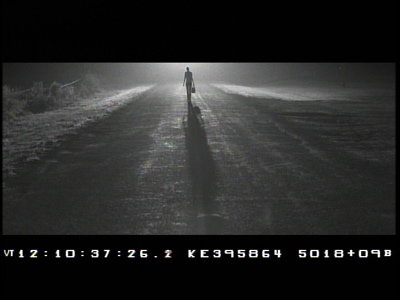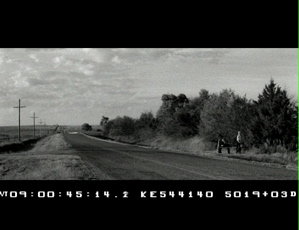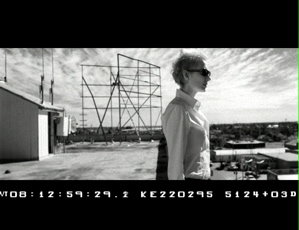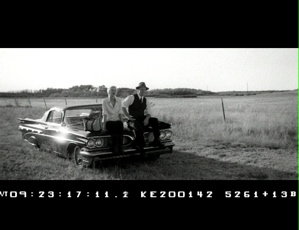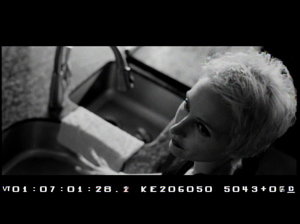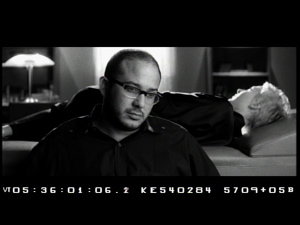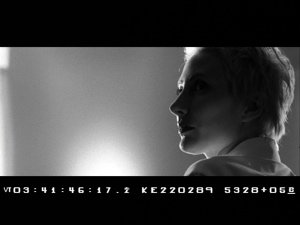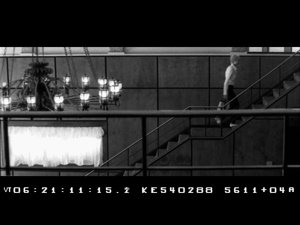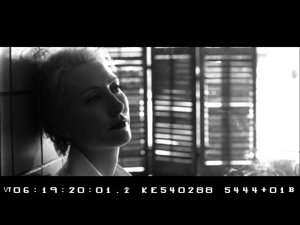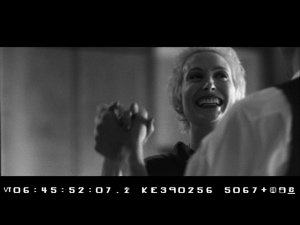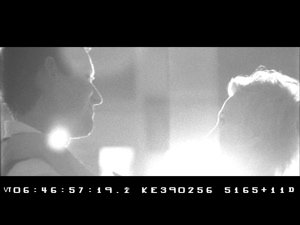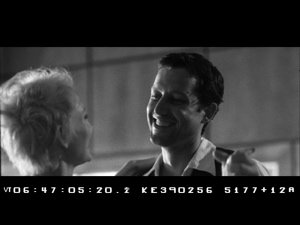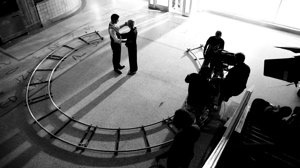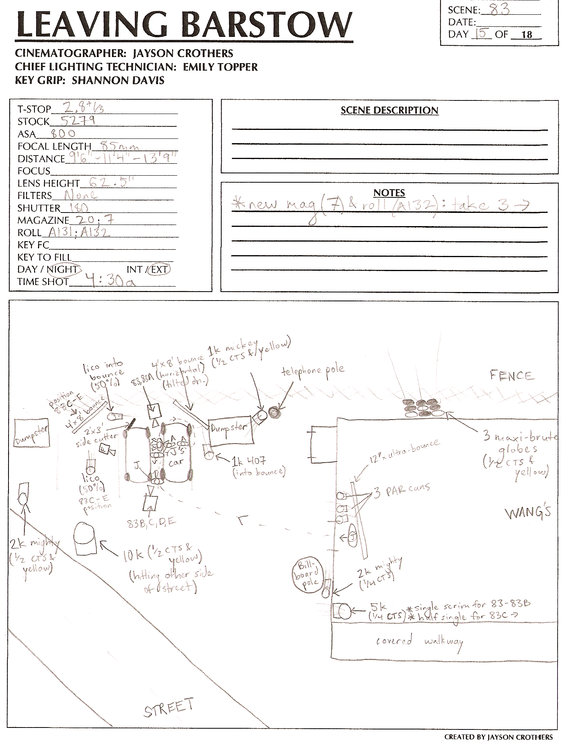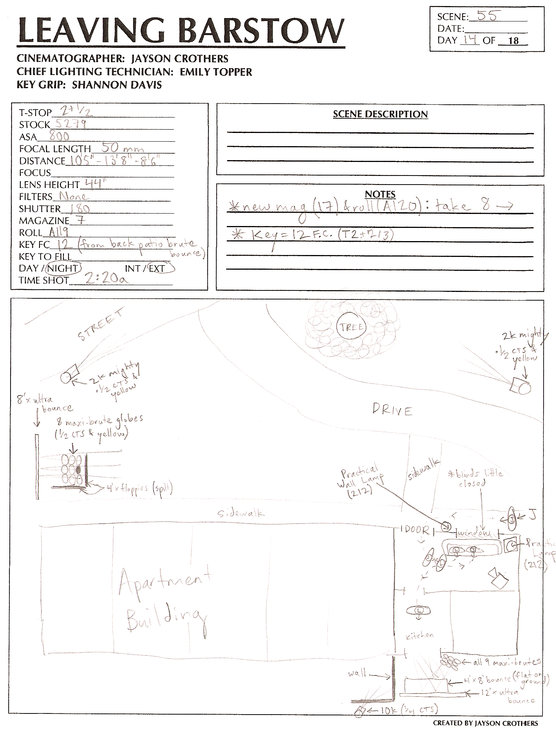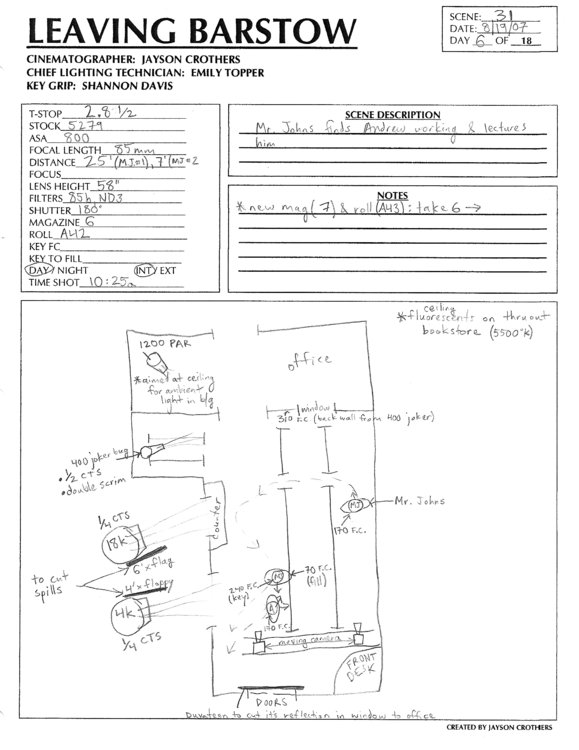
Jayson Crothers
Premium Member-
Posts
350 -
Joined
-
Last visited
Everything posted by Jayson Crothers
-
Loan for HVX200
Jayson Crothers replied to Kevin Seeley's topic in Students, New Filmmakers, Film Schools and Programs
Robert~ Thank you for stating that so well - even in interviews I'll occasionally get asked about what camera I think the production should shoot with......nevermind that I've only read the script twice and only met the director and producer 25 minutes ago! A lousy piece of equipment in a gifted filmmakers hands can still create something meaningful and professional. An amazing piece of equipment in the hands of a novice can still create something hollow and amateurish. I recall 2 thesis films from my school days that illustrate this point very well; one shoot had an outlandish budget and the filmmakers wanted to shoot on 35mm Anamorphic, large night exteriors in downtown, a technocrane - the works. They also had a poorly written script and were more interested in all the shiny things they could rent. The movie was quite terrible and to the best of my knowledge was never screened anywhere. The other thesis film had a really wonderful script and the filmmakers spent a great deal of time and energy working on how to best tell that story - it was shot on Super 16 with only a few bounce cards, a pick-up truck of some lights, and a great deal of talent. It's been screened at over 100 festivals worldwide and the Director was hired for a feature because of it and the Cinematographer has won a number of awards and got an agent from it. A mastery of the craft and an understanding of the artistic intentions make for quality work and success, not the equipment or even budget. If you're established within a market and owning a camera will strengthen your position or be profitable to you (ie, you rent that camera so often for your clients that you could own one and put that money into your own pocket), then by all means make the purchase. If you're buying the camera so you can market yourself as a Cinematographer, you'll only be joining a rapidly growing group of people who own gear but don't know how to apply the technology in either an artistic sense or as a business venture. If you want a camera to learn with, anything that records an image will do really. -
Stephen, I'll land in the evening on the 24th and I take off early on the 1st. It'd be great to get together with folks from the forum for a drink or two. How does everyone feel about the 29th? David, the general festival pass is about $45 or so (I don't remember exactly off the top of my head) in US dollars. You have to pay a few dollars for each movie there as I understand it. I'm finding that the festival itself is very cheap - hotel rooms aren't bad (mine is around $70/night). Check out their website for better info than I can provide. =) http://www.pluscamerimage.pl/
-
Has the witer's strike affected you yet?
Jayson Crothers replied to robert duke's topic in Jobs, Resumes, and Reels
"Heroes" shut down last week and "24" has their last day on December 3rd. I was at Technicolor last week and they were telling me that within the next week or so they were going to start cutting back on shifts and running at about half the man power. It was odd to see all the bins for the various TV shows they do completely empty...... -
Has the witer's strike affected you yet?
Jayson Crothers replied to robert duke's topic in Jobs, Resumes, and Reels
I just lost a feature due to the strike. I'd done 2 interviews and had been told by the director and then the producers that I was their guy and we were working out a deal memo for a feature in January. I was called yesterday by the director who was very upset because the Producers said they wanted to go with another person despite the directors objections. The only reason I lost the job? The DP the Producers are now hiring usually works in the 10+ million range of films (he has a few wide-releases to his name), but since the strike is on his newest film was put on hold and now he's available for this film (with a budget of about 1.5 million). If it weren't for the strike, he'd never even consider taking a film of this size (this is apparently what he told the Producers, but they're so eager to have someone of his caliber on board that they're willing to overlook the attitude). I don't take it personally (well, I'm not thrilled with those Producers, but I certainly don't hold it against the other DP); it's just the way of things. People have bills to pay, food to put on the table, mortgages, etc. The market gets flooded with people willing to jump down in pay-scale just so they can work and those of us who are currently living in that pay-scale have to compete with more experienced folks. I agree with the Writers, but I really hope it gets resolved soon so we can all get back to work. -
So I'm heading off to Poland for Camerimage in a couple of weeks, and since I've never been to Europe before, I'm also planning to go to Rome and then London for a few days. With that in mind I'm hoping some members on the forum who live in or are familiar with Rome and London (and Poland for that matter) might make some suggestions as to what to do, where to stay, what to avoid, etc. I've already got a wealth of suggestions from other folks, but I'm always happy to solicit more.
-
Stephen - WOW. This all looks great - the color combinations really work and I love the high contrast, dim lit look. Really fantastic. Did you shoot 2:35 common top or centered? Was there ever a discussion of 3-perf or anamorphic? I've found that if I'm working with a new lab/colorist (and I can't shoot any tests as is often the case with shorts) then I'll sneak in a little test with my framing chart; I'll shoot my framing chart, followed by a gray-card & chip-chart, then maybe a couple of shots with lighting ratios similar to what I'll be doing for the shoot or color combinations. Since I'm shooting the framing chart at prep, the next day I can see if they're matching to my gray-card and chip-chart or not.
-
The Naked Eye
Jayson Crothers replied to Jayson Crothers's topic in In Production / Behind the Scenes
Thanks for all of the great feedback - it's very much appreciated. David - I expect there to always be some issue(s) to work out, but it seems that the lower the budget the more ill-prepared (and knowingly ill-prepared) some of the directors are, etc. I rarely have had crew issues, and while the look of the film should elvolve a bit as you start actually shooting it, I was referring more to my desire to shoot better tests so as to fine tune technical details - that way the adjustments are more style and story changes rather than technical things. Toby - The shot of the man on the hood was done using an 85B- since there were no clouds in the sky (and since it was sunset and the light was already falling when we got to shooting it) I elected not to use a Red 25, Saulie - Yes, this was Hally. She was fun to work with (very easy-going), but not necessarily well-prepared in terms of knowing how she wanted to approach each scene. I had so many issues trying to track down a 3-perf camera that I never considered 2-perf. Mike - Yeah - she had a stunning face to light (her face loved the hard frontal light about 2 feet above eye line, or a VERY soft sidelight -exactly 90 degrees), but it was also particular. -
I've got to learn to stop rambling so much........these are much longer than I anticipated. WEEK TWO My favorite work of the entire shoot was this week. We started off the week shooting on the rooftop of the hotel we ended week one on. Since Oklahoma is so windy (and on the roof the wind could get as high as 35mph +), I couldn?t use any type of grip equipment up there ? the roof was painted white, so it basically became a giant bounce card. Since we keep favoring wider and wider shots, anything less than a 20K up there would have been ineffective and I wasn?t keen on making the crew try to get a 20K up the side of the building (there was only a small service stairway from the top floor to the roof). This day was a great example of using something like Sunpath and having a good relationship and communication with your first AD; our first AD is Katie Botkin ? she?s been a 2nd AD for a few years now and we?ve worked together on a lot of shows ? this is her first show as the first and she?s been doing a fantastic job. I planned out the shooting schedule based on the movement of the sun and told her that if we could shoot in a particular order and shoot certain scenes at certain times, I could wrap the day early and never need any equipment beyond a dolly and a bounce card. Sure enough, we used one bounce card and a doorway dolly and wrapped 4 hours early ? I kept the sun as a constant backlight and used the white roof as my bounce. We had great cloud formations in the morning and since the scenes were the only ones where our lead felt free from the dark interiors, I chose to use a Red 25 filter to make the contrast really snap. Most of this day was about composition and movement ? we shot a lot stuff that I was very happy with. The last shot of the day was suppose to a very wide shot that featured the sky in most of the composition ? unfortunately no clouds ever manifested themselves where we needed them, so the shot lacked much of the depth I was hoping for ? I?ve been finding that in B&W you really NEED clouds for day exteriors to give the sky any kind of definition ? otherwise it just becomes a big grey mass in frame. Day 2 of the week was a bit of a disaster that was somehow turned into a victory for us. We had to shoot a series of inserts, an abstract seduction scene, and a 2-person basketball game. The gym we shot in had beautiful woodwork and texture, but was part of an abandoned school and was very dirty, so while we were shooting elsewhere there was a crew cleaning up the gym. I?d planned on doing the inserts while my grips were rigging things for the seduction scene (there was a complicated overhead shot and a very involved dolly shot) ? before I could get my first shot off, our generator went down on us. No problem ? we pulled out a putt-putt, swapped to some smaller units, and started shooting. The inserts took a while since I was limited by the putt-putt genny (the location had no power) and then we were into the seduction scene; thankfully the generator had been repaired at that point (or so I thought). This scene was basically 2 shots ? a wide overhead shot and a 360 degree dolly ? we had to shoot in a classroom at the abandoned school, and without a jib, we had to build a rig to mount the camera into the ceiling ? my Key Grip (who?s been a life saver on this show) used parts from a car mount to rig directly to support beams that were above the panel ceiling ? this let me get about 12? above the actors and do a wide shot on a 25mm lens; I lit from the side with a 5K and a small forest of flags (the director wanted the scene to be very contrasty, dark, and abstract). I got off 2 takes and the generator died again; so back to the putt-putt I went, only now I had to swap to a 2K (and go from a T8 to a T4). I got off one more take before we had to move-on (the genny going down and having to swap around chewed up a lot time because we had to re-light each time). The dolly involved our Doctor character moving around our lead and trying to peel away her clothes while she keeps pushing him away ? we?d originally palnned to shoot this in a very large space with high ceilings and I?d intended to use a series of 2K?s and 1K?s (8 total) on dimmers to keep the characters in backlight (dimming units up and down) as we circled around them. However, our small room and low ceilings didn?t allow for this, so instead my Key Grip built a 14? menace arm with a 2K that was then mounted to the dolly- as we moved around our characters, the light was moving with us and keeping them in constant backlight ? I was very happy with the effect and I?m actually grateful that we had to come up with this approach because it worked better than I think the dimming lights would have. Again, though, we lost time because we had to shoot with sound and the putt-putt couldn?t be used, so we ended up sitting around waiting for the genny to get up and running. By the time we finally got the scene shot, there was no way to get the gym lit and shot as we had originally planned it ? the electrics had been busy with the genny problems, so nobody had been available to start pre-lighting. Fortunately this had been one of the locations I?d been able to do a proper tech scout at, so with a little help from Sunpath I was able to determine that we could use only the sun if we changed our shots and worked quickly ? the AD crew was great about quickly pulling everything together and with a little smoke I was able to get the shots we needed using just available light ? while I think the scene LOOKS better, I wish we could have lit it as originally planned to allow for more shots and more time to finess them ? as it was we were racing to get what we needed before we lost the light. The next day was a lot of jumping around ? all available light, but we were spread out across three different places on a ranch that covered upwards of a thousand acres. The morning was spent doing a few sunrise scenes (to serve as sunset) that involved only a dolly and an 8x8 checkerboard; while these were being shot the grips were setting up for the scene I?ve been most worried about. There?s a 5 page dialogue scene that the director and I conceived as doing in one very long dolly shot ? it started off as an extremely wide shot of two charactes walking through a fairly dense forest and arguing ? as the argument turns to a more serious fight we start dollying to track with them as they move closer and closer until they end in a medium shot against a tree - then we dolly around them about 90 degrees to end in a CU on our lead talking to someone off-screen. While I?d been excited about the shot, I was also nervous at trying to pull off 5 pages in one very long shot that involved a lot of people hitting all of their cues correctly. It took a bit of time to work out the kinks, but in the end the shot worked out far better than I?d ever expected and it was one of my favorite shots of the movie thus far (and one of my favorite scenes). We ended the day on another 1-shot scene that starts very wide on 2 characters sitting on the hood of a car after witnessing a car accident and ending on a MS of one of them ? we had to start the move on the actual road, but the car was off to the side which dipped about 5 feet down from the road, so my grips had to build up all the track ? since we?d see the end of the track in shot I pulled the last stick and decided to hide a zoom during the dolly move; we shot at magic hour to have a very low hard light as a backlight and started the shot on a 30mm and ended on an 85mm. The day following was a series of interiors in a very small room ? it was located on the second floor of a house, but had to stand-in as a first floor bedroom from a different exterior location. We couldn?t afford to rent any kind of a lift because we were so far away from anything (I was told the delivery charge would have been twice the actual rental charge), so my crew had to mount lights to the roof to get them in place ? this meant I was limited in where the lights could go, but because the interior was so small, there was literally no place to hide lights inside ? this was frustrating at times because it made things go slowly (setting a light on the roof took a long time to do safely), but I was happy because the limited space forced me to play things darker than I might have otherwise and I was happy with much of this day. The end of the day found me shooting a crucial scene after we?d lost the sunlight, so I was adding more and more lights at the last minute to try to blow out a curtain behind the actors in an effort to sell the illusion of daytime; again, I ran into the issue of the lens flaring more than I?d like, but overall I still think the shot worked. The next day was also a little screwy because of the previous day ? the previous day had gone longer than expected, so to make our turnaround for the next day the call time had to be pushed back; the trouble with that was that the entire day was day exteriors and it was at a very distant location (about 2 ½ hours away), so our shooting time was already very limited. For the most part the day went well ? a lot of dolly work that was made difficult by very uneven ground, but my grips performed some more miracles with the rigs they came up with on the spot. We shot the closing shot of the film as well ? a long zoom (about 60 seconds) of the lead walking off into the wild ? we started as a wide shot on a 250mm and slowly zoomed all the way out to a 25mm; again the sky was virtually cloudless ? I ended up using an 85B to try to get the one cloud formation to pop a little more, and I also used an ND 3 Grad that was slowly slid into shot as we zoomed out ? it worked well at the end of the shot. One scene was a little screwy because the high hills surrounding the location made us lose direct sunlight for the final 2 shots; we used a 10K to give some direction to the ambient light. The final day of this week was one of the toughest I?ve ever had ? it was our one night exterior and as soon as we arrived on location and started to unload we got hit by a giant storm; correction, TWO giant storms. We weren?t directly in their paths (one passed by us about 12 miles away and the other about 15 miles away), but they created some of the most intense winds I?ve ever stood in (at one point the weather report was saying around 45mph). We had to take all of our equipment down and wait for the storms to pass (at least we were audience to the most beautiful lightning storm I?ve ever seen ? at points it literally looked like daytime with how often and how bright the sky lit up). Since this was our last day with one of our actors, we decided to move the shooting order around and shoot a poor-man?s process driving scene first; I?d planned on setting it up while we were shooting our big wide shots, so now there was a little bit of a scramble ? on top of this, the director decided to do the whole scene in one shot and play it more theatrically and less realistic, so I had to make the gag sell for about 2 pages of dialogue. Luckily the wind helped sell the illusion quite a bit by blowing the actors hair around (and the dust flying by was free too!). Overall it looks fake, but in a good way that works within the story. We did a VERY wide shot of the lead walking down a long deserted highway ? I placed a 20K about a ¼ mile down the road and had it pointing straight back at the camera, but for a couple of reasons I wasn't able to get the light high enough to avoid a lens flare. To remedy this, we put a strip of gaffe tape across the matte box that was technically in frame, but since it?s so close to the lens we were focused past it and it served to darken the top of frame and eliminate the flare. Out of curisoisty, I also did a take without it and the horizon lit up a little like an alien spacecraft was landing ? an interesting look, but I preferred the darker version. The final shot of the evening was our lead stopping at the edge of town ? to fake the town we placed Christmas lights and various small units (inikies and tweenies) about a ¼ mile away pointed straight back at camera; I used a 135mm wide open to try to throw them completely out of focus ? the gag would have worked better with larger Christmas lights (the large clear globes are what I should have got versus the tiny lights). Dailies have been looking good for the most part ? everyone is still in high spirits. I?m having real trouble with one member of the crew, but for a variety of political reasons my hands are tied to do anything about it; it?s frustrating because this person is hurting morale and slowing down the whole process, but it seems nothing can be done about it. It?s personally upsetting too because I?ve worked with this person before and never encountered this ? I suggested them for the job, so to a certain extent it?s also reflecting on me. We?re only a week away from being done, so at this point it?s a matter of grinning and baring it. WEEK 3 ***I still haven?t seen dailies from this last week*** The first two days were tedious ? we shot in a motel room; an 11? by 10? white walled room. All of the scenes were heavy dialogue and the director wanted more minimalist set dressing, so I had nothing on the walls and virtually no furniture other than a bed, a small table, and two chairs. I ended up blasting a 20K through the one window and using a lot of negative fill to try to create contrast. For the most part I think I was successful (as successful as one can be when you?re shooting in a white box and doing long dialogue scenes in a static wide shot). I was grateful for the few day exteriors we had to do if only to get out of the tiny room ? there was some fun architecture and mirrored windows at the front lobby that I used to create some interesting compositions. The last four days were spent in a bar ? the toughest part of this location was that we were shooting from 2am to 2pm, so everyone was tired and that made everything run slowly. I?d originally wanted to use dedo-lights in this location, but since there?s no rental house within about 300 miles and by the time we got to these last four days there was no budget to ship them in, I elected to try to use par cans mounted above the drop ceiling. On day one we discovered that the bar was in BAD disrepair ? most of the ceiling was being held up by dried spray paint and some bailing wire (no joke), so we quickly abandoned mounting any lights and instead elected to hang 100 watt MR-16?s on thin wires to create sourcey pools of light that would appear in frame ? it made the bar look a bit more ritzy than intended, but we were out of options and the spirit of our original idea was still there. Most of the bar had to be lit from above, so we carefully placed small units in the few places my Key Grip felt safe about ? tweenies were mostly used, and I used a lot of inkies on the ground to create up-lighting on walls in the background to create separation. The work here was tedious because the bar became about lighting with almost exclusively separation rather than lighting in the traditional sense (does that make any sense?) ? since I couldn?t do a lot to light the bar as I would have liked to, I used a lot more lights than I normally do to try and create layers and silhouettes. In the end I think it worked, but it just took a lot more work than I?d originally anticipated. I used a little atmosphere here and there, but with our multiple backlights I found that even a little smoke felt like too much. The real life-saver in this location were the 100 watt MR-16?s; they had Edison bases, so we could screw them into overhead practials and get hot pools of light that fell off quickly. The surprise came on our last day when we wrapped about 4 hours early ? despite losing about a day and half up front, we still managed to wrap up early; I can?t stress how good the AD crew was on the shoot. In the end I can say I?m happy with most of the work ? I?m unhappy with a number of the locations that were selected because I really think location and production design make up at least 60% of good photography. I really enjoyed shooting black and white (and after seeing it for the past few weeks I can say there?s a marked difference in actual B&W versus color turned B&W) ? I wish I?d had more time to shoot more tests because I feel like the first 2 days of the shoot were a little experimental for me and I hate that it took me those 2 days to learn a few important lessons. My camera crew (1st AC David Levine and 2nd AC Brian Mohr) were fantastic ? not one soft shot in the entire film and everything was smooth sailing from start to finish. My Key grip Felipe Pena was a rock star every day ? nothing was impossible and he was inventive and fast. Ravi Gahunia (BB Grip), Xavier Leuvano (BB Electric), and Jarrod Wilson (Gaffer) also went above and beyond. I?m still impressed by how much we did with so little, but I also wish I could find a better way to explain to people that the most valuable resource on set (and the one that you should spend the most money on) is people, not equipment. We shot a Super 35 feature on location for about $150,000, but we could have made a much better movie (in my opinion) by shooting on Super 16 or even HD and spending more money on hiring more crew ? of course the movie would look different, but in the end it?s about making a better movie and not simply about it looking pretty. I?m getting tired of working with directors who don?t feel the need to do a shot-list; there are a few who can pull this off, but usually it just feels lazy to me and it leads to being less productive on set (and later on you wake up in the middle of the night thinking ?Damn, I wish I?d thought to do it THAT way instead???); in the future I?m going to insist that a director work on thinking through what they want in advance because it?s not a viable working method on low budgets to make it up as you go along. I also learned to be more careful about who I hire or suggest for hiring ? I rarely have ever run into a personnel issue on my shoots, but one person on this show really turned on me (so to speak) and it affected everyone I think; unfortunately the politics surrounding this person made it impossible to solve the issue without creating a host of other issues. Lesson learned. This was my ninth feature (all of them have been very low budget) and the thing I?m realizing I?ve learned the most is how to make informed decisions fast ? I?m proud and happy with the solutions we came up with on the shoot to solve some unique problems. What I?m not happy with is that on low budget productions like this I keep running into the same issues over and over and they seem to be a common issue no matter who?s running the show. In the future I?ll start pushing more for the things I know are going to be really important ? I think my issue now is that I try very hard to be the guy who?s always positive and works hard to find a solution (I never want anyone to hear me say ?No?) ? I think I need to start being more honest about things and saying ?That?s not a good way to do this and will hurt us down the road, but here?s an option??? AND be able to push for it until the production gets it, rather than saying ?Oh. Um. Yeah. We?ll figure out how to do that.? The first shot we did on the hospital roof - that's just the sun and a Red 25 on the camera - while the rising sun was beautiful, we were still an hour or so too early for any clouds, so this shot is somewhat void of definition in the sky. Later in the day we had about 40 minutes of an amazing cloud formation that worked quite well for our scene. Day 2 - This was the first thing we shot - I was using an 85B to try to make the clouds pop a bit more (there wasn't much there to begin with); since the shot was already rather contrasty (the tree line on the right was quite dark) I didn't want to use a Red 25. This was shot about 30 minutes later and the sky was totally bare - the weather in the panhandle changed faster than I'd have guessed. Grabs from the long dolly shot - it actually begins MUCH wider than the first one (that first one is about 3/5 of the way into the scene), but without the movement of the characters they are diffiuclt to see in a still frame. The one variable in each shot was that clouds kept rolling through the shot, so we'd go from high contrast to very flat, then back to high contrast - a couple of takes I was riding the iris a little to make the shot work, but for the most part I let it go because I was liking how the lighting was changing as a reflection of how the characters are changing and fighting. The beginning of this shot is on a 30mm and I dollied forward on about 20' of track as I also zoomed in to end on an 85mm. They're being filled in with an 8x8 Checkboard, but upon hindsight I might have backed it off a little and played it a little darker. One of the insert shots I did for a montage - it's a series of shots of our lead getting an examination. I had an idea of her lying down and seeing a beam of light (like a cat-scan) move across her. There's a tweenie into the ceiling above her that's reading about 4 stops under key. The beam of light is from a 50 degree source 4 (about 2 1/2 stops over key) that's mounted on our gear head so I could smootly control the tilt and movement of the beam. Our overhead shot - a 25mm about 12' high; this is lit with a 5K and an army of flags. It's exposed at a T8 and she's at Key; the dark side didn't even read. This is the end of our 360 degree doilly track - imagine the entire shot looking like this. The backlight mounted to the dolly via a menace arm kept the whole scene very moody and worked great. One of the few gym shots we could get - we added a lot of atmosphere to the room (in hindsight, too much, but we were all running in a mad dash to get the shots before the sun vanished). This is all available light - my grips removed a window panel in the upper portion of this frame to help give me a primary beam of light to work around, but other than that we didn't do anything else to the lighting. Our small bedroom interior - the only light inside the room is a Source 4 that's creating the light on the left wall - outside the window they're in front of is a 10K and a 5K. To get this I pulled open the bedroom curtains and used the 10K as a single hard source. This is primarily lit only be our 20K - since I could only get the 20K into one position safely, I had to work certain things around it. In this case, I moved the bed so that the cuts of light on the wall behind her are naturally created from the headboard of the bed. A curtain on the window helped create a soft key for the lead. The sun was gone at this point - in addition to the 10K and 5K outside the window, I also used 2 2K's and 2 Par 64's to blow out the curtain. Inside they're both being lit by a Source 4 into a 4x4 beadboard off to the right. The final shot of the movie as our lead walks away - again, there were almost no clouds, but we didn't have the time to wait or to re-schedule it. It's a T8 1/3, starting on a 250mm and zooming all the way out to 25mm as she walks away. I slid an ND 3 grad filter in from the top of the shot to help try to get the ckouds at the end. I liked this location a lot - endless possibilities for composition. There's a 10K on the pin edging them both (it's very subtle with all of the sunlight). We only got 2 takes of this - one was with natural sunlight and the next one was a fabrication with me using bounce cards and a 10K. This is part of our opening sequence - nothing more than a 20K pointed back at the lens (there's a Par Can off to screen right that's barely lighting her). The top frame has a strip of tape across the top of the frame to remove the flare, but the bottom frame is a clean lens. This is our fake city skyline (well, one of the many we created) - the christmas lights don't play much, but the inkies and tweenies pointed back at camera were convincing. She's being keyed with a 5K and a 2K cross-lighting her.
-
I'm going this year - I've been wanting to go for a number of years but was always (fortunately) working. This is the first November where I don't have something overlapping the festival, so off to Poland I go......
-
So between multiple colds, bad internet connection, and a desire to post some stills, I?m putting all three weeks up at once. I need to learn how David manages to post updates every week???.. WEEK ONE We didn?t even start the shoot before we took a big blow ? one of our actors got called in for a recurring role on a TV show and had to miss the first two days of the shoot; since everyone is coming from LA and we found out about 3 days before we started shooting, there were no options to change the schedule around and suddenly our 18 day shoot became a 17 day shoot. Our first day was very light ? we shot the very few things we could that only involved our lead actress (also the director) ? it wasn?t much. The only advantage to this situation was that it let everyone get into a good rhythm and let us work out some kinks. On this first day we did a fun day-time poor man?s process shot that worked surprisingly well ? I?m trying to figure out how to post a Quicktime file of it. It involved a bounce card and a 4x4 cucaloris swung around on a menace arm. All of our set-ups were pretty simple this day and it was a good opportunity for the director and I to finesse some larger ideas. Days 2-4 were brutal ? we had to make up for the lost day and a half within these three days and it was all dialogue. In addition, this was my least favorite location both logistically and aesthetically. In the second chapter of the movie, our lead finds herself at a hospital and spends all her time with a Doctor there. These three days were all the scenes in his office and her room ? the director wanted his office to be stark and simple; a desk, two book shelves, and a therapy couch. She wanted these few pieces of furniture to be set inside a gigantic space that rolled off into black around them. The location she chose (despite my protests) was the second floor of a Church Activity center ? the walls were all white, there was no elevator, and the window the office was set around had the equivalent of an ND 15 on it. We aren?t doing remotely as many set-ups as I?m use to; nearly all of the scenes are being done in 1-shots. In some cases this is an interesting choice on telling the story, but I believe it?s largely because the director doesn?t know much about editing, plus she comes from a theater background so she?d rather play the entire scene out as opposed to shooting it in pieces. This is creating a lot of headaches because I?m being forced to shoot 2, 3, or 4+ pages in one shot. My approach to these was to find a starting place for the characters in their relationship within the scene, then find how that relationship changes at the end; once we had that down, I?d work out a camera move to get from point A to point B ? this was the only way I could find an interesting way to visually represent certain ideas. I?m doing a lot more dolly work than usual (most everything is a camera move) and we spent nearly the entire week shooting on a 35mm lens ? it?s a happy compromise of not being too wide but being wide enough that I can maintain some deeper focus to avoid having to ping pong focus back and forth within in a long scene. I?m surprised that I?m shooting a T4 most of the time ? I don?t think I?ve EVER shot at a T4 for interiors; I usually work at around 320 asa or 400 asa and a T2/2.8 ? here I?m working with 200 asa and a T4 (and on occasion I was shooting at a T5.6 to keep a deep focus look). I?m also using almost exclusively hard light, which has been a fun challenge to learn how to light faces with hard light. The office set was mostly a 20K on a lift outside the window (and even when dropped on the pin we only got a T8/11 through all the ND on the location window); I put a tweenie on the pin above each book case and had 2K BJ?s rigged into the ceiling as backlights. Over the past year and a half I?ve been getting away from backlighting, but in B&W I?m finding myself placing multiple backlights for people ? it?s been pretty common to have two crossing backlights to define the shape of our actors and then an inkie or a tweenice just as a hairlight. I?m also finding myself using primarily unmotivated light ? I?m always adding little spots and highlights on back walls and furniture ? we?re using them to create tonal separation between people and their environments. The onboard monitor has been invaluable this first week to get into the mind-set of seeing things in B&W. I dusted off my B&W contrast glass and that?s been very useful in seeing how colors will manifest themselves in terms of tone. I?d originally planned on using some light smoke to create a big shaft of light from the 20K through the window, but between the ND on the window and the white walls (which partially motivated me to go for a deeper stop in an effort to get them to disappear more) I dumped that idea. One thing I?m doing that I?ve never done before is using lighting cues within a scene ? since we?re B&W I?m only using tungsten sources (no HMI?s or kino-flos) and they?re usually on dimmers. As characters move through various spaces I find that it?s impossible to light for everything without the scene becoming flat or uninteresting, so my solution has been to have my electric crew dimming lights on and off as people walk through spaces ? it?s been a challenge to get use to thinking this way since I?ve never done it before, but that?s been part of the fun. The dailies from Technicolor have been great ? the best dailies I?ve ever seen from anything I?ve shot. They?re consistently solid and despite being on DVD they?ve been a surprisingly good presentation of what I?m doing on set. Technicolor printed a few rolls for me from this week so I could compare the prints to the DVD dailies ? it?s a little funny to see them cropped so strangely (since we?re shooting Super 35 the printed dailies are only a lighting and exposure reference and not at all for composition), but they held up very closely to what I was seeing on the DVD?s. Technicolor has also sent me an email or a phone call every day with my printing lights ? something they suggested and pushed for me. I can?t say enough good things about them. The last day of this week was one of my favorite locations ? it?s an old hotel from the 50?s that?s now being used an office supply store. It has a gigantic lobby with a huge chandelier, original tiled flooring, and oak paneling. We scouted the location originally for just the roof (which we?ll shoot next week), but I suggested we move a lot of the hospital office scenes to the lobby and stage it as the hospital lobby. There were two challenges here ? the first was a series of small windows scattered through-out the main lobby and along a second story balcony that were full of office equipment that we couldn?t move ? to solve this problem I asked the art department to dress each window with linen curtains that I could then glow to mimic them as windows to the outside ? the issue there was that each window had a window decal on it that we couldn?t remove (Service Department, Show Room, etc) ? any light we placed behind the window would project a razor sharp shadow of the decal on the curtain. The solution was to place cutters a few inches away from the decal and then use multiple sources through multiple frames of diffusion (in this case, each window got 2 2K BJ?s through 4x4?s of first opal and then 216) to create a very soft, very bright light that backlit the curtains ? by making the light soft, it wrapped around the cutter on the decal and still blew out the window. The other big challenge was that the lobby had windows running along the entire south side ? while there was very little direct sun-light that came into the lobby (thanks to an awning on the building?s exterior and the time of year), there was a constant ambient light. This worked for the first half of the day by giving me a base ambience to work from, but when it came to scenes that had to shoot towards the windows I couldn?t possibly compete with the exterior exposure. Instead I placed a 20K and a 10K to create hard light and long shadows for wide shots ? then I underexposed everything by an additional 2/3 to a full stop (additional to what I was already doing) and counted on the extreme overexposure to flare the lens and make up for the extra underexposure. For nearly everything this worked quite well ? I tried this idea on a short I did earlier this year and it worked out; since I?ve used Zeiss Superspeeds so often, I have a good sense of how they react to overexposure in terms of flaring ? I was able to minimize some of the overexposure by setting the lens to a deeper stop and the flare compensated for the extra underexposure ? I was bit by one shot that I should have underexposed some more (it?s very washed out), but otherwise my idea worked well. I did one 270 degree dolly shot around our lead as she dances with the memory of her dead lover ? we shot at 40fps on an 85mm (the first time I used that lens for the whole week). I used the 20K as a hard sidelight on them with a 2k BJ spotted on them for a backlight to pull them out from the background ? as we dollied around them we were flared from the 20K and during that transition I had the original 2K BJ dimming down while another 2K BJ on the opposite side of the room was dimming up ? when we clear the flare they?re still in a hard side-light and have a backlight. The flare was a lot of fun because the 20K was broken up by the architecture of the front windows and their moving bodies, so we got a fractured quality of light ? it?s not one overpowering flare but rather a myriad of little flares. I?ve been finding that an edge-light 1 ½ stops over with fill being 3 stops under is looking quite nice ? our lead actress is very pale and I?ll expose her at key (key according to my incident reading ? in reality her skin tone is nearly a full stop hotter). B&W lighting is very unnatural to the eye, but the more contrast the better ? and the grain is less apparent in higher contrast shots as well, only appearing when there?s a large area ?at key?. My 1st AC gave me his cold on Day 2 and I just barely got over it by the last day of this week ? I?m happy to be working with a great Producer and a great 1st AD who both make it possible to still be out at 12 hours despite the workload. Below are some frame grabs - I recently updated my mac and with the update my screen-grab program stopped working - I ended up using a bit of a backdoor method, but it's not very good and there's no way to toggle to an exact frame, so a lot of these were a matter of luck in terms of what I could pause on. Anyone have suggestions for DVD screen capture software for Mac OS X? The opening shot of the film and the very first thing we shot - I like the abstract nature, but looking back I would have used a hot spot behind her instead of the hairlight, or perhaps I would have just added a little hot spot in the very bottom left (the cropping on this is wrong - I somehow grabbed the still incorrectly). A baby for the hair-light and a Studio 2K thru a 4x4 of 250 for the key light (and an 8x8 negative fill off to camera left). Also shot on day one - this is an example of how a movie changes during the shoot - while I like the shot well enough, I've come to believe it was a bad choice for this film - it's too self conscious I think. A 2K BJ thru a 4x4 of Lite Grid and a bounce card below camera for a little fill. A shot of our lead and the doctor in his office - one of our brightest scenes in here (it's towards the end of their affair and I continued to open up the office in terms of brightness as the story progressed to reflect how the doctor is losing his sense of mystery to our lead). A 20K blasting through the window behind them, a 2K BJ as an edgelight on them (mounted into the ceiling), a 2K BJ thru a 4x4 of Opal, then another 4x4 of 216 off to camera right with a 4x8 negative fill off camera left. The bookcase on frame right in the background has tweenie in the ceiling pointing straight down on full pin. Our lead's first scene in the doctors office - this shot is while she's waiting for him to arrive. The 20K is hitting her as a backlight and her shirt is acting as a bounce on her; a 2K offscreen on camera right is giving her an edge and the hotspot at the bottom of the frame is a tweenie aiming down towards the bookshelf (which is off screen in this shot) - a little 2x2 beadboard card added just a kiss of fill for her. Our lobby - ambient light serving as fill and a 20K at full flood for the long shadow - a meat-axe is creating the cut on the wall to the right. The window is an example of the multiple soft sources wrapping around a window decal to blow out the curtain evenly - in this shot we had to use Par 64 cans. The window had two with medium lenses thru 4x4's of Opal and then 4x4's of 250 to diffuse the light more. The window decal can't be seen. Part of a pull back as our lead crosses the lobby and goes upstairs; this is half way through the move. The opening was the camera on an offset arm shooting down over the edge of the railing - we dolly back as the lead crosses and goes upstairs - all the lines in the location were a lot of fun. This is the shot towards the windows that I should have underexposed more - it's too washed out because of the flare....... .......but luckily a little adjustment of brightness and contrast can remedy the error. This is just the available light outside and a 10K on the pin as an edgelight on her (at some point she smokes and the 10K really helped punctuate the smoke). This is a favorite shot of mine because it starts as a wide shot of her lying there and rapdily pushes into this when she realizes the ghost of her dead lover has arrived. These are aren't the best grabs on my behalf, but these kind of show the edgelight that begins on them as they dance and we dolly around them - the third frame shows that the edgelight is now on the other side of the room via two electricians and some dimmers. A behind-the-scenes of the dolly shot in the lobby - you can see the second backlight 2K on the right; otherwise it's just the 20K and some ambient light.
-
The Naked Eye
Jayson Crothers replied to Jayson Crothers's topic in In Production / Behind the Scenes
So I'm finally back and am about to post my blogs (a lousy internet connection in the Panhandle made the 5 weeks there pretty tough) - I wanted to answer a few of the questions posted here first. David - Your advice about silhouette and more contrast was invaluable; it seems like half the film was in silhouette and it was the best way to go. It's a wildly unnatural way to light, but vital for B&W. I had one day scene in overcast weather and sure enough the 5222 would have been muddy in it - I exposed for the sky and made our actors a little more of a silhouette against the endless gray, so that helped. I agree that carrying 2 stocks isn't usually an issue, but in this case it would have been trouble - the director would often change her mind about a scene ("Let's make this a night scene now", or "Let's stage this outside instead") and her shooting ratios were wildly varied through-out the shoot - after we wrapped I compared my inital breakdowns to what we actually shot and had I carried 2 stocks I would have run into a problem at the end of week 2. But you're right in that it's not usually an issue and this was just an isolated case. And the 85 filter was a great compromise when I wanted more snap than a Yellow 8 (very subtle) but less punch than a Red 25 (very pronounced). John - I did a B&W short when I was about 19 where I lit all of our actors with red lights and then used a Red 29 filter - an interesting look to say the least, but it's not very practical to gel all of the lights with such a heavy gel. I would have been fighting to get an exposure of any kind (though it IS a unique look). Mike - Underexposure was key, so again, thanks for the advice! To minimize grain, it was about contrast (faces were usually about 1/2-1 stop over key, their fill was around 3 to 3 1/2 stops under, and edge-lights were anywhere from 1 to 2 1/2 stops over). I usually shot at a T4 when I'd normally shoot at a T2.8; that extra underexposure helped a lot to bring down grain. -
I'd be very cautious about the inexperiened pilot - a good friend is a DGA AD and about a year ago a show he was 1st'ing lost a producer, a camera operator, and the inexperienced pilot when the pilot hit a power line while they were trying to shoot some 2nd Unit stuff. When I was about 19 I went up and did some handheld helicopter stuff - it was useless. I suppose a major component is the type of helicopter you're in, but the shaking of the chopper made everything but the widest lens a mess. I'd urge the producer to look at renting an actual camera mount and to look for an experienced pilot of some sort.
-
The Naked Eye
Jayson Crothers replied to Jayson Crothers's topic in In Production / Behind the Scenes
We're only shooting 5222; this is largely because the budget is low enough that I was concerned about carrying two stocks and finding myself in a situation where I didn't have enough of one stock left to shoot a scene or having to shoot a scene on a "wrong" stock. I also like the simplicity of having one stock (when it's realistic to do this) - I can get familiar with one stock and work a bit more freely once I have a good handle on it. I'm carrying a full assortment of color filters - the Red 25 is a VERY dramatic look and while I like it, I feel like it may be too heavy for much of the film. I tested a Green filter that may serve us well for a large day forest scene, and of course a Yellow 8 will almost be a given for our day exteriors. I'm also carrying a few other odd colors as well, but after looking at the tests I'm not sure exactly where I'd find an application for them. A DI down the line has been discussed, but at the moment nothing is final. My feeling is that everyone is expecting this to not go back to print, but it's still a lingering question. When we chose to go with Super 35 over Anamorphic, I immediately suggested 3-Perf, but the best deal we could get on the camera was for a 4 perf package only. I was finding that 3 perf cameras were tough to come by. When we compared the cost of a 4 perf package to the higher cost of a 3 perf package with the savings on film stock, it wasn't much of a savings (we don't have a lot of film and the cost of the film is quite low to begin with). For a bigger shoot I'd push harder for it, but in this case it wasn't a big enough difference to go to bat for. Part of the choice to shoot B&W over color was aesthetics and part was budget; aesthetically there's a difference that the director really reacted to. I preferred B&W over color, but ultimately it was the director calling for it. Budget-wise it was a substantial savings; we paid about 1/2 the cost for B&W stock as opposed to a color stock - THAT was a substantial enough savings that I pushed for it. The only benefit to shooting color would have been more speed (I could have gone with a 500 asa stock over the 200 asa of 5222) and grain, but the 200 asa isn't a major headache given our locations and lighting package, and the grain is a trade-off that I can live with. The film calls for very dramatic hard light; if this was a film with a more natural look, I would have looked harder at shooting on color and doing the B&W in post, but given it's visual style, the higher contrast of B&W serves us very well. -
I wasn't clear in my question - I wasn't clear if he actually rated the stock at 100 asa (hence shooting a neg that's a full stop overexposed and then printing down) or if he was rating it at 200 asa but when it came to lighting only people and faces he was "over-lighting" as though it were a slower asa. Between David's explanation, re-reading the article, and a few other sources, it sounds like he rated at 200 asa and then just pumped up the light on faces.
-
I?m in Guymon, OK finishing up my prep for a new feature I?m shooting called ?The Naked Eye?. It?s a noir-inspired story about a womanwho?s on the run from a combination of the mob, her lover, and a mysterious man who?s following her. It?s a combination of modern day environments and situations with characters and dialogue straight from a noir crime story ? the dialogue is fast and sharp, the woman is a tough gun-toting dame, etc. We?re shooting on 4-perf Super 35 in Black & White (one of the biggest appeals to me for the film) ? the visual language of the film is interesting because there are so few rules and the influences are so wildly varied ? Fellini has been a influence in terms of tone, as well as Antonioni?s ?L?Avventura?. The director sees the film as mostly done as one-shots (a wildly different approach than my last film). The film lacks any sense of a linear timeline and scenes often run in consecutive order and then jump ahead to different days to continue a conversation ? in many ways the film places more importance on each individual scene and together they form the story, versus each scene being there to serve the entire story. It?s difficult to understand and discussing this film with everyone on the production is a very abstract exercise. I?d say it?s a film more about mood, tone, and atmosphere more than it?s a film about a particular story. The budget is very low and the crew is very small, but the director (who also wrote it and is starring in it) was adamant about wanting to shoot on 35mm ? it?s making every other department very strapped, but I won?t ever complain about getting to shoot Super 35. I?d done some tests earlier this year for a B&W short that explored 7222 versus 7217 turned into B&W in telecine. For that short I chose to go with the 7212 because I liked the absence of grain and the wider latitude ? but there was (in my opinion) a marked difference between actual B&W stock and color stock that?s made into B&W later on. For this film (and especially since my director is very much a purist) I felt an actual B&W stock was a better call. I use to love Ilford?s motion picture stock, but since they?re discontinued, that left me with just 5222 or 5231. I only got a few hours, but I was able to do some rudimentary tests of 5222 (basic exposure tests and some color filters) and found the film to be much grainier than I?d expected. I really want a cleaner look for this film, but we don?t have the resources to shoot with only a 64 asa stock, so I settled on 5222 (my colorist at Technicolor is working with me to possibly use noise reduction to clean up some of the grain). After looking at a print of the tests, I also observed that I have certain habits that die hard ? I learned Cinematography primarily from an old-school foreign Cinematographer who was very traditional and very hard-nosed; it was beaten into my head day after day that you always shoot a thick negative, so I became accustomed to shooting very thick negatives with very high printer lights. On my last film, (where I felt like I did a lot of underexposure with my neg), my lights were what most people would consider normal (I typically find my lights in the low to mid 40?s). We printed my tests to color stock (purely a budget reason and they have a red tint that I?m not a fan of ? I recall Wally Pfister having the same complaint for the B&W sequences in ?Memento?) and they came in around the mid-40?s. B&W has been a big learning curve for me in terms of latitude ? there?s considerably less and it?s pretty counter-intuitive to what I?m use to with today?s color stocks. About 3 - 3 ½ under and things go to muck and about 2 over and they?re really burning up. Technicolor has been great ? they were telling me about a really interesting lab process they?re currently using to make all the prints of ?American Gangster? ? it?s called the ?Oz? process and it?s their answer to ENR. I?m shooting on a BL 4 that?s provided by Hollywood Camera again; zeiss super speeds with an Angeniuex Zoom thrown in for a handful of day exteriors and one planned zooming shot. We chose to shoot 2:35 center mostly because the director said she?d prefer to not have to think about two compositions at once, and that this was a festival film in her mind, so she didn?t want to have to consider protecting for TV as well; it?s a bit of an odd spot for me because I?m use to always protecting for different deliverables (a feature I short last year had me protecting for four different aspect ratios), but I?m happy to not have to compromise compositions for once! Since I didn?t have time to test the idea, I went with the logic that the center of the lens is optically superior to the edges, and since I wasn?t protecting for anything else, there was no reason to use a common top-line, and in turn an ?inferior? part of the lens. We?d given serious consideration to anamorphic (it was the plan we started with actually), but our budget is really low and getting deals on decent anamorphics was a real challenge. Clairmont gave a very generous bid that involved their Clairmont Anamorphics; I went and looked at them and while they have a look that I found really interesting (wide open they truthfully stop looking like film and start looking like a water-color painting- the focus takes on a liquid quality, very intriguing), they needed to be around a T5.6 to look right for this film, plus there were only 5 focal lengths available (32mm, 40mm, 50mm, 75mm, 100mm). Combined with the fact that we?re so far away from any type of production hub or resources (and Hollywood Camera?s bid included a back-up body and duplicates of many items), I couldn?t in good faith pursue Anamorphic as the best choice given our limited resources and distant location. The locations are a mixed bag of really spectacular and terribly mundane; some of them only require me to point a camera at them and they do most of the work for me, while others were selected based on the director knowing she could get them. Gratefully the look of the film specifically calls for an abstract approach and look, so with the less-than-ideal locations I can take some pretty big liberties in how I shoot them. Oklahoma and Kansas are beautiful (vast and barren, but beautiful) ? the sunsets make me wish (briefly) that we could shoot in color. I also want to say thank you to David Mullen for a few clarifications he helped make for me and Mike Williamson for offering some advice from his B&W experience.
-
There's an old BBC documentary about Storaro floating around - I saw it years ago when a former teacher of mine lent it to me on VHS. I'll hunt around and see if I can find it somewhere - it was very indulgent but extremely interesting to see him explain and demonstrate his ideas and beliefs.
-
About 3 years ago John Toll had Kodak run a fairly large order of 5293 for a film, but I was told by the Kodak rep that he ultimately chose not to use it. I did a short film with it and I can't say enough how much I loved the snap and contrast. I know Kodak was offering some good deals on it, so you may try calling the LA office to see if they have any left.
-
Leaving Barstow
Jayson Crothers replied to Jayson Crothers's topic in In Production / Behind the Scenes
It was a fight with the producer and I lost - she worked out a deal with Kodak that I couldn't beat with Fuji (though Fuji did make a really generous offer). Same thing with the pull process - after I was told I had to use the 5279 and 5274, I tried getting a go-ahead on pull processing, but also lost that battle due to budget. I tested the Ultracons and some low-cons, but the director didn't much care for them. I never looked at the Smoque filters (but thanks for the tip, I'll look into them next time). I didn't want to use any smoke because there's a lot of hard light in the film and I didn't want any shafts of light - plus keeping the smoke consistent would have been havoc on the schedule and the way my director liked to shoot. We ended up shooting more film than had originally been budgeted for, so it would have been even more expensive to do pull-processing. In the end we just had a budget that was too tight to do everything we wanted - in an earlier posting I think I observed that it really should have been on Super 16, but everyone was determined to make it go on 35mm. -
I'm prepping a B&W feature and I keep running into wildly different opinions on certain questions. I've read that "Schindler's List" ran into issues with static discharge in the mags due to the silver content in B&W emulsions that resulted in lines and dots appearing on the film. The only practical solution sounded like damp sponges placed inside the camera body, but even that sounds questionable to me. How much of an issue is this really (is it climate based or just inherent to shooting on B&W)? Kaminski also mentioned (although a bit vaguely) that he treated 5222 (200 asa) as though it was a 100 asa stock; it's not clear if he simply over-exposing in his lighting or if he was actually rating the stock at 100 asa and then printing down one stop. How does over-exposing/printing down and under-exposing/printing up differ in B&W versus color? I was able to shoot some tests (though they were very abbreviated) and I was surprised by how grainy 5222 is; I expected some grain, but it seemed excessive (especially when compared to something like "Schindler's List") - my printer lights were quite high (low to mid 40's). Any thoughts or advice on ways to minimize grain (I know that sounds like a silly question, but it can't hurt to ask)? Thanks everyone!
-
Leaving Barstow
Jayson Crothers replied to Jayson Crothers's topic in In Production / Behind the Scenes
Scene 83 was one of our night exteriors - again, there are a few shots listed on one sheet. There's also a 10K with a 1/2 CTS + Yellow gel pack to the left of the dumpter on the left side; the unit didn't play for the first part of the scene but was eventually used to give a subtle rake to a long dark building in the deep, deep, deep background. -
Leaving Barstow
Jayson Crothers replied to Jayson Crothers's topic in In Production / Behind the Scenes
Scene 55 was one of the tougher scenes to light. As you can see, the camera is inside an apartment living room and pans with our actress who is coming up to the door from outside. She comes into the room, wakes up her grandmother, then sits down. The apartment was suppose to be somewhat dark, but both actresses are African American and the walls were stark white! The large space outside proved challenging because we see so much and I didn't have the time to really light them properly, but I didn't want them to just vanish. Ultimately I'm happy, but it was a result of a fast crew and a couple of happy accidents. -
Leaving Barstow
Jayson Crothers replied to Jayson Crothers's topic in In Production / Behind the Scenes
The lens for this (Scene 44) was actually a 50mm and not a 35mm as listed. Since we were moving so quickly, Scotty didn't have time to re-sketch things, so typically he drew in most of the camera positions on one overhead (as seen here) and then made notes for each shot on a separate sheet. It takes a second to decipher it all, but it proved to be very useful in terms of seeing how all the camera positions came together to build the scene. -
Leaving Barstow
Jayson Crothers replied to Jayson Crothers's topic in In Production / Behind the Scenes
While I'm not allowed to post stills from the film, lighting plots are fine. These were done by our camera intern; I grabbed a few on my way out the door, so these are in no particular order. As you'll see, some information is missing and every once in a while things were noted incorrectly (to his credit though, he always caught the mistakes and made note of it, so we were able to use these religously to help maintain continuity over the shoot). On this first one (Scene 31) we had about 50+ 8' daylight fluroescents in the ceiling that served as our base ambience. -
Leaving Barstow
Jayson Crothers replied to Jayson Crothers's topic in In Production / Behind the Scenes
It's still being debated; even after looking at the neg it seems nobody can agree on what the cause was. I suppose it's interesting to have so many intelligent people saying "That's a first", but I'd much rather find the reason. If/when I get to the bottom of it, I'll let everyone know. -
I'm prepping a new film and the director is in love with the idea of shooting it in Anamorphic. We'll very likely be going through Clairmont for our gear and I recall seeing a short a few years back that had an interesting look and was shot at very wide stops on the Clairmont Anamorphics; no idea if that's the direction we'll go, but I'm curious. I'm working out scheduling to go shoot some tests of my own, but was wondering if anyone had any experience/opinions regarding them. Thanks!



